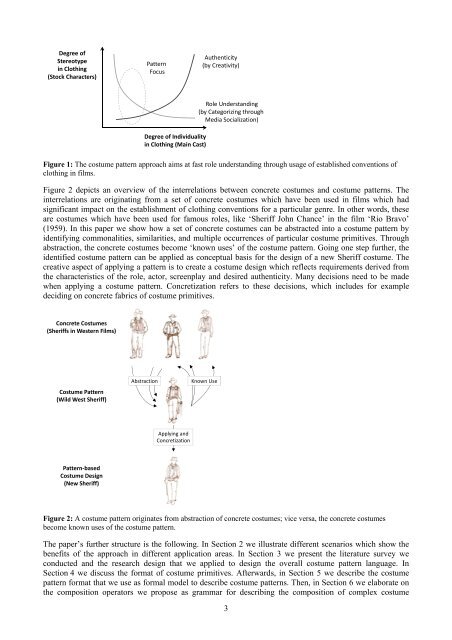A Pattern Language for Costumes in Films - IAAS
A Pattern Language for Costumes in Films - IAAS
A Pattern Language for Costumes in Films - IAAS
You also want an ePaper? Increase the reach of your titles
YUMPU automatically turns print PDFs into web optimized ePapers that Google loves.
Degree of<br />
Stereotype<br />
<strong>in</strong> Cloth<strong>in</strong>g<br />
(Stock Characters)<br />
<strong>Pattern</strong><br />
Focus<br />
Authenticity<br />
(by Creativity)<br />
Role Understand<strong>in</strong>g<br />
(by Categoriz<strong>in</strong>g through<br />
Media Socialization)<br />
Degree of Individuality<br />
<strong>in</strong> Cloth<strong>in</strong>g (Ma<strong>in</strong> Cast)<br />
Figure 1: The costume pattern approach aims at fast role understand<strong>in</strong>g through usage of established conventions of<br />
cloth<strong>in</strong>g <strong>in</strong> films.<br />
Figure 2 depicts an overview of the <strong>in</strong>terrelations between concrete costumes and costume patterns. The<br />
<strong>in</strong>terrelations are orig<strong>in</strong>at<strong>in</strong>g from a set of concrete costumes which have been used <strong>in</strong> films which had<br />
significant impact on the establishment of cloth<strong>in</strong>g conventions <strong>for</strong> a particular genre. In other words, these<br />
are costumes which have been used <strong>for</strong> famous roles, like ‘Sheriff John Chance’ <strong>in</strong> the film ‘Rio Bravo’<br />
(1959). In this paper we show how a set of concrete costumes can be abstracted <strong>in</strong>to a costume pattern by<br />
identify<strong>in</strong>g commonalities, similarities, and multiple occurrences of particular costume primitives. Through<br />
abstraction, the concrete costumes become ‘known uses’ of the costume pattern. Go<strong>in</strong>g one step further, the<br />
identified costume pattern can be applied as conceptual basis <strong>for</strong> the design of a new Sheriff costume. The<br />
creative aspect of apply<strong>in</strong>g a pattern is to create a costume design which reflects requirements derived from<br />
the characteristics of the role, actor, screenplay and desired authenticity. Many decisions need to be made<br />
when apply<strong>in</strong>g a costume pattern. Concretization refers to these decisions, which <strong>in</strong>cludes <strong>for</strong> example<br />
decid<strong>in</strong>g on concrete fabrics of costume primitives.<br />
Concrete <strong>Costumes</strong><br />
(Sheriffs <strong>in</strong> Western <strong>Films</strong>)<br />
Costume <strong>Pattern</strong><br />
(Wild West Sheriff)<br />
Abstraction<br />
Known Use<br />
Apply<strong>in</strong>g and<br />
Concretization<br />
<strong>Pattern</strong>‐based<br />
Costume Design<br />
(New Sheriff)<br />
Figure 2: A costume pattern orig<strong>in</strong>ates from abstraction of concrete costumes; vice versa, the concrete costumes<br />
become known uses of the costume pattern.<br />
The paper’s further structure is the follow<strong>in</strong>g. In Section 2 we illustrate different scenarios which show the<br />
benefits of the approach <strong>in</strong> different application areas. In Section 3 we present the literature survey we<br />
conducted and the research design that we applied to design the overall costume pattern language. In<br />
Section 4 we discuss the <strong>for</strong>mat of costume primitives. Afterwards, <strong>in</strong> Section 5 we describe the costume<br />
pattern <strong>for</strong>mat that we use as <strong>for</strong>mal model to describe costume patterns. Then, <strong>in</strong> Section 6 we elaborate on<br />
the composition operators we propose as grammar <strong>for</strong> describ<strong>in</strong>g the composition of complex costume<br />
3
















